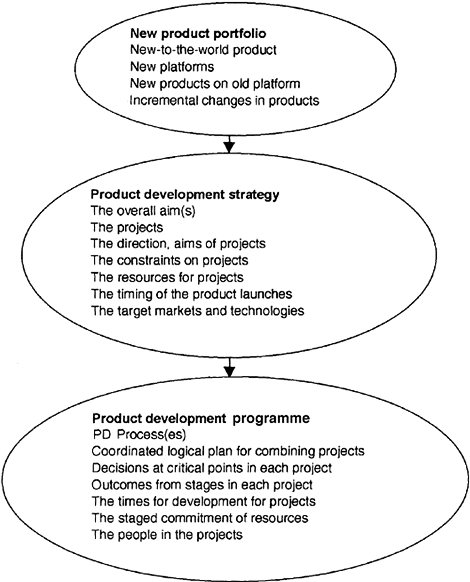FOOD
PRODUCT DEVELOPMENT
Mary Earle, Richard Earle and Allan Anderson |
| Loading
|
|
||||
|
|
Part 2, Chapter 2
Developing an innovation strategy 2.6.4 The overall product development strategy
The product development strategy lies between the new product portfolio and the product development programme as shown in Fig.
2.14.
 Fig. 2.14 Developing the product development programme.. They are interconnected and there is recycling between the three as the final product development management plan develops in the programme. The product development projects are being identified from the product portfolio, and the PD Processes and their management gradually built up. This is a creative as well as a controlled process as the ideas for the products and the projects are being developed. The aims of the new product development strategy can be specific:  the structure of the product mix; the structure of the product mix;
 increase the percentage of sales from new products to 30% in five years; increase the percentage of sales from new products to 30% in five years;
 returns on investment from new products; returns on investment from new products;
 specific products to be launched in each year; specific products to be launched in each year;
 returns from specific products or sales in a new market. returns from specific products or sales in a new market.
But they can also be subjective, for example developing the image of a health-providing company, or products of superior quality. They can also be organisational, for example using up the slack production, developing a new distribution system, developing a new subsidiary. As stated previously, there may be aims for the organisation of the product development, for example being more systematic, separation of incremental and innovative product development, decreased time to market. The individual projects and their aims, objectives and constraints are also starting to be developed although the detail may come later in developing the product development programme. The aim of the project, the ultimate outcome desired by the top management, is specified. This aim must be definite and not vague, straightforward and not complex. It must mean the same to all people, the management that are confirming it at this time, and the people who are developing the product commercialisation 6-12 months from now. This aim is the guide to the product development planning and also to the decision making during the project. It needs to be agreed in the product development strategy, although it may develop in detail as the product development programme is developed. It needs to state the type of product, the target market, the technology (or method of processing and distribution), the type of plant available, the marketing methods and the size of the market needed. There may be choices in this aim because there is a need still to study several methods of processing and marketing, and even several different markets. There are also limits or guidelines developing for the total product development programme and the individual projects. They are specified levels of resources, and these need to be allocated to the different projects. The amount of spending on each project is always specified, but there is also a need to recognise the knowledge priorities, in other words people with different types of knowledge. Where are people with specific technological or marketing knowledge needed, where is there a need for creative design, strong financial analysis and consumer research? Where is there a need for different types of managers - senior/ junior, leaders/controllers, knowledge leaders/system leaders? The resources of people, finance and equipment are limited and priorities and timing have to be determined. Some projects may have immediate priorities, because they have to be launched quickly or they are major projects that will take some time but need to be started immediately. There is also a need to identify how the new product development is to be achieved - internal R&D, internal product development, licensing, joint venturing or acquisitions (Cooper, 1998). The timing of the product launches is set, since this is usually critical because of seasonal and other market conditions. The timings of particular stages such as product commercialisation which involve a great deal of resource from the functional departments and also need to be fitted into the present production and marketing, are outlined at this stage as they are the basis for developing the product development programme. In developing the product development strategies, it is important to specify the type of market - consumer/retail, industrial and food service. In the latter two, the service is as important if not more important than the product and really what is being developed is a product and service strategy. This means that the human factor becomes more significant and the human resource strategy has to be integrated with the product strategy, creating a new product/service that has to include communication and understanding. The service can be an improvement or a new service, just like the products, but consideration in developing the new service has to be given to the consumer and to internal staff participation (Atuahene-Gima, 1996).
|
|
 |